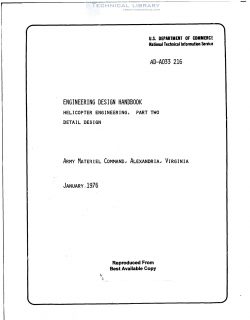AMCP-706-202
- Version
- 784 Downloads
- 46.79 MB File Size
- 1 File Count
- March 5, 2017 Create Date
- June 4, 2019 Last Updated
Engineering Design Handbook - Helicopter Engineering - Part II; Detail Design

06•202, Engineering Design Handbook, He!icopter Enginer.•iq. Parr Two. Detail Design. is the second part of a th:ec-voiume helicopter engineering design handbook. Thc preliminary design (covered in AMCP 706-201) is •veloped during the proposal phase. at which time all sub- systems must be defined in sufficient detail to deter- m.ne aircraft configuration, weight. and pcrfor- mance. The detail design involves a reexamination of all subsystems in order to define each clemcnt thoroughly with the aims of optimizing the aircraft wi:h regard to mission capability as well as cost con- siderations. Detailed subsystem specification requirements are the basis for in-depth analysis and evaluation of sub- system characteiistics and interfaces. Based upon complete system descriptions and layouts. pcrror- mancc. weight. end cost trade-offs arc finalized. Periodic reviews of the design are. conducted to evaluate maintainability. reliability. safety. produci- bihiy. und €onforr,jancc with specificatioa require- mcnts. Development testing may be required to pet mit evaluation of alternate solutions to design problems or to obtain adequate information for trade-off in- vestigatiuns. Apprepriatc considcraåon or human engineering factors often requires evaluation of infor. mal mock-ups.
Weight control is an important element of the detail dcsign phase. Subsystcm weight budgets. pre. pared on the basis or the preliminary design group weigh! breakdown, arc at the initiation of the detail design phRse. The continuing evaluatlOn of compliance with thc budget as an csscntial part of the manzgcmcnt of the projec' und the B€,suran't of com- pliance with weight guarantees of the helicopter de- tail specification are described in conjuncuon with the discussion of the Wcight Engineering (unction In AMCP 706-201 The requirements and procedures fot airworthi- ness qualification and proof Of Contract compliance for a new model hcltcoptcr for the US Army are defined and discussed in A MCP 706-203. which is the third volume in this handbook series Qualification is not time-phased. but •s a continuing part of the ac- quisltion program. A number Of qualification requirements are integral parts of the detail design ef- fort.
| File | Action |
|---|---|
| AMCP-706-202 Engineering Design Handbook - Helicopter Engineering - Part II; Detail Design.pdf | Download |

Comment On This Post